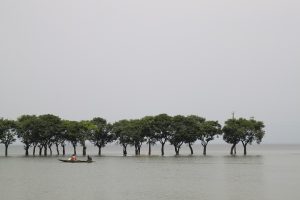On April 16, Roshan Lal Negi woke up to find snow carpeting the courtyard of his home in Jangi village. Boys with smartphones quickly made videos to share on WhatsApp but more than a month later, the dusty snow still sits on the lower parts of most peaks in Kinnaur district, Himachal Pradesh.
Particles from a dust storm in the northern plains might have travelled to Kinnaur and mixed with the unseasonal snowfall, suggests Manmohan Singh, director of the meteorological centre in Shimla, giving the dusty appearance. The jury is still out, but most agree that this rain shadow region is experiencing a drastic shift in its weather patterns.
Rains are increasing, snowfall is declining, and temperatures are rising, which all have great impacts on an area prone to landslides and fed by glacial melt. In addition to global climate change, local development activities such as hydropower projects, road expansion and deforestation are adding to the chaos.

Falling stones, sliding farms
“Life is tough here,” is the most common refrain heard from Kinnaur locals, and they’re not just talking about the harsh winter months when caution signs appear on the highway warning of falling stones. Even a light rain can trigger landslides, potentially holding up traffic for a day.
With a highly-porous sandy and gravelly soil, and sparse green cover, all three subdivisions of the district are highly vulnerable to landslides. Drilling for hydropower projects and blasting for expansion of roads add to the incidences of landslides. The disaster of 2013 – when three days of heavy rains triggered numerous landslides, killing 10 people and damaging roads, houses, farms and apple orchards – is still fresh in people’s memory.
As the Himalayan Region warms up faster than other places of the world, erratic weather puts geographically-vulnerable places such as Kinnaur at greater risk. Droughts and excess rainfall are more frequent and more intensely felt due to the shift in farming, from coarse grains to commercial plantations of apple and green peas.
Winter snowfall is also now more spread out. “The heavy snow in December and January has declined and there’s increased activity in February and March,” says S S Randhawa, senior scientific officer at the state council for science, technology and environment.

The decadal average number of rainy days has increased by 43%, from 77.4 days in 1980-90 to 111 days in 2000-2010, according to data from the National Initiative on Climate Resilient Agriculture. The number of dry spells during the Kharif season, on the other hand, shrank to 10-15 days, while most dry spells between 1980 and 1990 lasted more than 20. This increased rainfall leads to a greater erosion of fertile topsoil, and infestations of pests that thrive in the humidity.

Mighty apple takes a beating
Kinnaur is famous for big and brightly-coloured apples, features which are caused by low nightly temperatures. Historically, the amount of crop lost to inclement weather has been low. In April and May, while apple trees in the district’s capital Shimla and the adjoining hills are adorned with white nets to protect against hailstorms, orchards in Kinnaur enjoy clear weather. But increasing rainfall and declining snowfall is pushing people out of this routine.
Cooler winter temperatures are important to induce dormancy, bud break and to ensure proper flowering in apples. But less snow, also reported in other parts of Himachal Pradesh, means that this crucial cool factor is not met, affecting apple quality and quantity.
Apple growers in Kinnaur’s low- and mid-altitude hills felt that rising temperatures had affected apple production, but farmers at more than 3,000m reported no decline due to temperature, according to a 2013 study. Most growers also reported a shift in the apple harvesting period due to increasing temperatures. The infestation of pests and diseases – including apple scab and canker – are some climate change indicators that increase the cost of production.
Four years later, things are worse. This April, a month which typically sees the flowering and setting of fruits, has seen light showers almost daily. “Rains reduce the chances of pollination as bees are more likely to stay in their hives,” says Rakesh Kumar, an entomologist at the regional horticultural research and training station of the Y S Pramar University of Horticulture and Forestry.
A traditionally dry region, the area does not have the means to deal with excess rainfall. “Farms don’t have proper drainage facilities as people never needed them. This leads to waterlogging and the infestation of diseases and insects which thrive on humidity,” says a plant pathologist who wished to remain anonymous. “There are also higher chances of water transferring from the basin of infected trees to healthy ones due to undulating farms.”
Bhagat Singh Negi, a farmer in Rarang village, is worried that not even 30% of apple trees will bear fruit. “New diseases crop up every year and even the chemicals we use are not as effective now. This year, many flowers dropped due to lack of pollination. It will be a difficult time for Kinnaur’s economy,” he says.
Prudent about pesticides
Extreme weather events are also catching people unaware. In 2015, the Pooh sub division received far less snow than usual, which dried the irrigation sources used to water apples. “We had to get water in tankers to save the trees. There was no harvest that year,” says Gurmeet Negi who owns an apple orchard.
The villages of Tabo and Sunam in upper Kinnaur saw incessant rain in June 2014, usually a dry month, which led to an infestation of ascochyta blight of the green pea crop. “Not a single plant was safe,” says the plant pathologist. “The market value of pea dropped drastically.”
Farmers in Kinnaur take great pride in their low use of agrochemicals but the reluctance of growers to spray chemicals also adds to the problem. “Farmers usually spray miticide when they see the damage that mites have done to plants. By then, infestation is already big enough and needs more sprays. This not only kills beneficial insects but is bad for health and farm economics,” says Kumar.
Shalkar village in the Hangrang Valley issued a blanket ban on pesticides after a revered Buddhist monk asked the villagers to shun violence. “He did not specifically talk about chemicals, but we decided to ban them to avoid killing insects,” says a villager.
Other villages, however, are seeing a rise in chemical use. “Up until eight years ago, we used to spray chemicals only twice in a year,” says R C Negi of Thangi village. “Many would go without but now the frequency has gone up to seven sprays.”
Return to traditional crops
The solution may lie in traditional crops which are enjoying a resurgence. Different varieties of buckwheat, called ogla and fafda, used to be grown in Kinnaur as main crops. Today, however, these are only cultivated for occasional family consumption or at higher altitudes where apples don’t grow as well. These crops, along with jowar (sorghum) which some farmers still intercrop with apple, are known to be more resilient to pests and diseases.
Known as ‘Kuttu ka atta’ and consumed by those who fast during the Navratras and Shivratri festivals, the health benefits of ogla flour are also gaining fame. “Ogla and fafda are known to be good for diabetics and heart patients. Since these varieties are restricted to limited areas now, the farmers get a good price,” says R C Negi. In Chitkul, the last inhabited village of the Baspa valley near the Indo-Tibetan border, the flour made from ogla and fafda fetches around Rs 160 (USD 2.48) per kg.
Designing for rainy days
In such a difficult setting, successful apple harvests bring some cheer. People make enough money to send their children to school, and to upgrade their houses to be more resilient to weather shocks. Concrete is fast replacing locally-sourced wood and stone as the preferred building material while traditional flat mud roofs are giving way to metal pent roofs.

“Some residents, who are concerned about preserving their traditional building styles, are experimenting with tarps and waterproofing clays as part of the flat roof layering system, or building the roof at a subtle gradient,” she says.
Besides the change in character of traditional Himalayan houses, the shift also affects more functional aspects of a flat roof as a storehouse and social space. “The flat roof is used as an additional space for sitting during social gatherings such as marriages and deaths because the houses are generally small,” says Shanta Kumar Negi who runs a tourist resort at Nako. “People used to help each other clear snow from the roofs but with a pent roof, which is regarded as modern and more useful, social interactions are declining.”
People in Kinnaur are used to living on the edge, but they have not yet to come to terms with sudden shifts in weather. And if this year’s dusty snow is any indication, the situation will not improve any time soon.
![<p>The traditional flat roofs are giving way to metal pent roofs in Nako as climate change affects precipitation [image by Manu Moudgil]</p>](https://dialogue.earth/content/uploads/2017/05/The-traditional-flat-roofs-are-giving-way-to-metal-pent-roofs-in-Nako-300x201.jpg)







